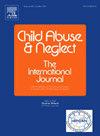儿童虐待和药物使用对创伤后应激障碍症状和异常同伴关联的纵向研究:虐待发育时间的影响
IF 3.4
2区 心理学
Q1 FAMILY STUDIES
引用次数: 0
摘要
儿童受虐后,青少年往往会出现PTSD症状并使用药物。然而,很少有研究涉及异常同伴关联和再受害的纵向潜在影响以及PTSD症状和物质使用对发展的影响。目的为了解决这些局限性,本研究利用易感性和自我药疗假说,对儿童期0-12岁和青少年期12-16岁滥用药物作为16岁青春期中期药物使用和18岁青春期后期PTSD症状的预测因子进行了研究,研究对象为596人(73.8%为少数种族;50.7%男性),来自儿童虐待和忽视的纵向研究。方法本研究采用结构方程模型(SEM),采用自举方法研究儿童虐待、药物使用、异常同伴关系和创伤后应激障碍症状在不同发育时期的直接和间接影响。结果青少年中期药物使用介导了青少年滥用与创伤后应激障碍症状的关系,而童年期药物滥用与青少年中期滥用无间接关系。此外,儿童虐待与16岁时PTSD症状之间的间接影响是由12岁时PTSD和14岁时越轨同伴关系介导的。青少年物质使用、PTSD症状和青少年同伴社会网络可能是减少未来不良后果的干预点。结论:本研究的发现为遭受儿童虐待的长期后果和随后的不良后果提供了证据,包括创伤后应激障碍症状、药物使用和青少年越轨同伴关系。本研究还强调了预防和干预机制,以减轻这些不良后果。本文章由计算机程序翻译,如有差异,请以英文原文为准。
A longitudinal examination into childhood abuse and substance use to PTSD symptoms and deviant peer association: Impact of developmental timing of abuse
Background
Following child abuse, adolescents often endorse PTSD symptoms and use substances. However, few studies have addressed the longitudinal underlying effects of deviant peer association and revictimization and the developmental impact of PTSD symptoms and substance use.
Objective
To address these limitations, the current study utilized the susceptibility and self-medication hypothesis to examine abuse in childhood ages 0–12 and adolescence ages 12–16 as predictors of substance use in mid-adolescence at age 16 and symptoms of (PTSD) in late adolescence at age 18 mediated by associating with deviant peers and revictimization using a sample of 596 (73.8 % racial minority; 50.7 % male) adolescents from Longitudinal Study of Child Abuse and Neglect.
Methods
This study utilized structural equation modeling (SEM) to examine the direct and indirect effects of child abuse, substance use, deviant peer affiliation, and PTSD symptoms across different developmental periods using bootstrapping procedures.
Results
Results indicated that substance use in mid-adolescence mediated the relationship between abuse in adolescence and PTSD symptoms in middle adolescence, while the abuse in childhood was not indirectly related. Furthermore, the indirect effect between abuse in childhood and PTSD symptoms at age 16 was mediated by PTSD at age 12 and deviant peer affiliation at age 14. Substance use in adolescence, PTSD symptoms, and adolescent peer social networks may be a point of intervention to reduce future adverse outcomes.
Conclusion
The findings of this study provided evidence of the long-term consequences of experiencing child abuse and subsequent adverse outcomes, including PTSD symptoms, substance use, and adolescent deviant peer affiliation. This study also highlighted preventive and intervention mechanisms to attenuate these adverse outcomes.
求助全文
通过发布文献求助,成功后即可免费获取论文全文。
去求助
来源期刊

Child Abuse & Neglect
Multiple-
CiteScore
7.40
自引率
10.40%
发文量
397
期刊介绍:
Official Publication of the International Society for Prevention of Child Abuse and Neglect. Child Abuse & Neglect The International Journal, provides an international, multidisciplinary forum on all aspects of child abuse and neglect, with special emphasis on prevention and treatment; the scope extends further to all those aspects of life which either favor or hinder child development. While contributions will primarily be from the fields of psychology, psychiatry, social work, medicine, nursing, law enforcement, legislature, education, and anthropology, the Journal encourages the concerned lay individual and child-oriented advocate organizations to contribute.
 求助内容:
求助内容: 应助结果提醒方式:
应助结果提醒方式:


